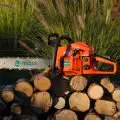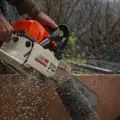When it comes to cutting wood or other materials, two of the most commonly used tools are the reciprocating saw and the chainsaw. Both have their unique strengths and weaknesses, and choosing the right tool for the job can make all the difference in terms of safety, efficiency, and overall results.
In this article, we’ll take a closer look at a reciprocating saw vs chainsaw and discuss which one is best for different types of cutting tasks.

Table of Contents
- Reciprocating Saw
- Types of Reciprocating Saws
- Chainsaws
- Chainsaw vs Reciprocating Saw – Which to Use When
- Conclusion
- FAQs (Frequently Asked Questions)
Reciprocating Saw
A reciprocating saw, also known as a Sawzall, is a handheld power tool that features a blade that moves back and forth in a reciprocating motion. The blade is designed to cut through a variety of materials, including wood, metal, and plastic, making it a versatile tool that is widely used in construction, demolition, and DIY projects.
Strengths of Reciprocating Saws
Versatility
One of the primary strengths of a reciprocating saw is its versatility. With the right blade, it can cut through a wide range of materials, making it ideal for a variety of tasks. Whether you need to cut through wood, metal, plastic, or even masonry, a reciprocating saw can get the job done.
Portability
Reciprocating saws are generally lightweight and easy to carry around, making them ideal for use in tight spaces or for working in areas where mobility is key. They can be used with one hand, which makes them a great choice for overhead-cutting tasks or for cutting in hard-to-reach areas.
Ease of Use
Reciprocating saws are generally easy to use, even for beginners. They don’t require a lot of skill or experience to operate, and they can be adjusted to different speeds and cutting depths depending on the task at hand.
Weaknesses of Reciprocating Saws
Precision
While a reciprocating saw is a versatile tool, it may not be the best choice for precision cutting tasks. The blade moves back and forth in a relatively rough motion, making it difficult to achieve smooth, precise cuts.
Safety
Reciprocating saws can be dangerous if not used properly. The blade is exposed and can cause serious injury if it comes into contact with skin or other body parts. It’s important to wear protective gear, such as gloves and safety glasses when using a reciprocating saw.
Types of Reciprocating Saws
Reciprocating saws are versatile cutting tools that are available in a variety of different types. Each type is designed for specific applications, and choosing the right one can make a big difference in the efficiency and quality of your work. Here are some of the different types of reciprocating saws:
- Corded reciprocating saws
- Cordless reciprocating saws
- Compact reciprocating saws
- Orbital reciprocating saws
- Dual-mode reciprocating saws
- Specialty reciprocating saws
Corded Reciprocating Saws
Corded reciprocating saws are powered by electricity and have a cord that needs to be plugged into a power outlet. They offer consistent power and are ideal for heavy-duty cutting tasks that require long run times. Corded reciprocating saws are typically more powerful than their cordless counterparts, and they’re also more affordable.
Advantages:
- Consistent power for heavy-duty cutting tasks
- No need to recharge batteries or worry about run time
- Typically more affordable than cordless saws
Disadvantages:
- Limited mobility due to the cord
- Not suitable for remote or outdoor use
- May require a power outlet and extension cord for use in certain locations
Cordless Reciprocating Saws
Cordless reciprocating saws are powered by rechargeable batteries, making them more portable and convenient than corded saws. They’re great for working in areas where there’s no power outlet or where a cord would be a hindrance. Cordless saws are typically less powerful than corded saws, but they’re still capable of handling many cutting tasks.
Advantages:
- Portable and convenient, no need for a power outlet
- Can be used in remote or outdoor locations
- Lightweight and easy to maneuver
Disadvantages:
- Limited run time, may need frequent battery changes or recharges
- Typically less powerful than corded saws
- More expensive than corded saws
Compact Reciprocating Saws
Compact reciprocating saws are smaller than standard reciprocating saws, making them ideal for working in tight spaces or for overhead cutting tasks. They’re typically cordless and use a smaller battery than standard reciprocating saws. Compact saws are not as powerful as their larger counterparts, but they’re still capable of handling most cutting tasks.
Advantages:
- Smaller size and lighter weight make them easier to handle and maneuver
- Ideal for tight spaces or overhead-cutting tasks
- Typically cordless, allowing for more flexibility in use
Disadvantages:
- Less powerful than standard reciprocating saws
- Limited blade options and cutting capacity
- It may require more frequent battery changes or recharges due to the smaller battery size
Orbital Reciprocating Saws
Orbital reciprocating saws have a circular motion in addition to the back-and-forth motion of standard reciprocating saws. This motion allows the saw to cut more aggressively and quickly through wood, metal, and other materials. Orbital reciprocating saws are ideal for tasks that require fast and efficient cutting, such as demolition work.
Advantages:
- Faster and more efficient cutting through wood, metal, and other materials
- Great for demolition work or other tasks that require quick, aggressive cutting
- Still able to make straight cuts when the orbital function is turned off
Disadvantages:
- Can be difficult to control and may produce more vibration than standard reciprocating saws
- More expensive than standard reciprocating saws
- Limited blade options due to the orbital function
Dual-Mode Reciprocating Saws
Dual-mode reciprocating saws offer both orbital and straight-cutting modes. This allows the user to switch between modes depending on the type of material being cut. Dual-mode reciprocating saws are ideal for cutting both wood and metal, and they offer a more versatile cutting experience than standard reciprocating saws.
Advantages:
- Versatile cutting experience with both orbital and straight cutting modes
- Ideal for cutting a variety of materials, including wood and metal
- Can be used for both demolition work and precision-cutting tasks
Disadvantages:
- More expensive than standard reciprocating saws
- May be heavier and bulkier than other types of reciprocating saws
- May have more complex controls and settings to navigate
Specialty Reciprocating Saws
Specialty reciprocating saws are designed for specific applications, such as cutting drywall, pruning trees, or cutting through metal. These saws typically have unique features, such as adjustable shoe plates or specialized blades, that make them better suited for their intended purpose.
Advantages:
- Designed for specific cutting tasks, providing optimal performance and efficiency
- Can be more precise and produce cleaner cuts than standard reciprocating saws
- Typically have specialized features or blades that make them more effective for their intended purpose
Disadvantages:
- May have limited use beyond their intended purpose
- More expensive than standard reciprocating saws
- May require specific blades or accessories that are not widely available
Chainsaws
A chainsaw is a power tool that features a chain that rotates around a guide bar. The chain is made up of sharp teeth that cut through wood or other materials as the chain moves around the guide bar. Chainsaws are commonly used in forestry, landscaping, and construction.
There are different types of chainsaws, which we won’t go into detail about here. In short, there are gas-powered, electric, and battery-powered. You can learn more about them in our electric vs gas chainsaw guide!
Strengths of Chainsaws
Cutting Power
Chainsaws are designed to cut through thick, dense materials quickly and efficiently. They can make short work of even the toughest cutting tasks, making them ideal for use in forestry and landscaping.
Precision
Chainsaws are capable of making precise cuts, particularly when used with a guide or jig. This makes them a good choice for tasks that require a high degree of accuracy, such as cutting lumber for construction projects.
Efficiency
Chainsaws are fast and efficient, allowing you to cut through large volumes of material quickly. This can save time and energy, particularly when working on large-scale projects.
Weaknesses of Chainsaws
Size and Weight
Chainsaws are generally larger and heavier than reciprocating saws, making them less portable and more difficult to maneuver in tight spaces. They also require two hands to operate, which can make them more tiring to use over extended periods.
Safety
Chainsaws are powerful tools that can cause serious injuries if not used properly. The exposed chain and sharp teeth can cause lacerations and amputations if they come into contact with the operator’s body or other objects. It’s essential to wear protective gear, such as chaps, helmets, and eye protection when using a chainsaw.
Chainsaw vs Reciprocating Saw – Which to Use When
Simply put, when it comes to a reciprocating saw vs chainsaw for a job keep the following in mind. If you need to cut up larger chunks of wood and don’t mind being messy or making a lot of noise, a chainsaw is an ideal option. It is designed to easily cut through huge pieces of wood and may be used for longer periods of time for larger operations.
The reciprocating saw is ideal for smaller chores such as clipping small branches from trees, cutting down saplings and breaking apart smaller pieces of wood.
Cutting Capacity
When it comes to cutting capacity, chainsaws are the clear winner. They are designed to cut through thick, dense materials quickly and efficiently, making them ideal for tasks such as felling trees or cutting large branches. Reciprocating saws, on the other hand, are better suited for cutting smaller, thinner materials, such as metal pipes or plastic tubing.
Precision
For tasks that require precision, such as cutting lumber for construction projects, a chainsaw is a better choice. Chainsaws can make precise cuts when used with a guide or jig, and they are capable of cutting through large volumes of material quickly and efficiently. Reciprocating saws are less precise and better suited for rough-cutting tasks.
You can find the Best Firewood Chainsaw in our guide!
Portability
Reciprocating saws are generally lighter and more portable than chainsaws. They can be used with one hand, making them ideal for working in tight spaces or for overhead cutting tasks. Chainsaws, on the other hand, require two hands to operate and are generally less maneuverable.
Safety
Both reciprocating saws and chainsaws can be dangerous if not used properly. However, chainsaws are generally considered more dangerous due to their size and cutting power. It’s essential to wear protective gear when using either tool, but extra precautions should be taken when using a chainsaw.
Safety should always be a top priority for any power tool user. When it comes to chainsaws, you must know how to use them safely and wear the correct PPE. Visit our guides to learn more:
Cost
When it comes to cost, reciprocating saws are generally less expensive than chainsaws. Reciprocating saws can be purchased for under $100, while chainsaws can range from $100 to over $1,000.
However, the cost of a tool should not be the only factor considered when choosing between a reciprocating saw and a chainsaw. It’s important to choose the right tool for the job to ensure safety and efficiency.
Conclusion
Choosing between a reciprocating saw and a chainsaw depends on the specific task at hand. For tasks that require precision cutting, such as cutting lumber for construction projects, a chainsaw is a better choice. For cutting smaller, thinner materials, such as metal pipes or plastic tubing, a reciprocating saw is a better choice.
When it comes to safety, both tools can be dangerous if not used properly, so it’s essential to wear protective gear and follow proper safety guidelines. Ultimately, the choice between a reciprocating saw and a chainsaw should be based on the specific needs of the task and the user’s level of experience and comfort with the tool.
Other tool comparisons:
FAQs (Frequently Asked Questions)
Can I use reciprocating saw to cut tree?
Yes, a reciprocating saw can be used to cut trees, but it is not the best tool for the job. Reciprocating saws are primarily designed for cutting through wood, metal, and other materials, and can be effective for pruning branches or cutting smaller trees. However, when it comes to larger trees, a chainsaw is a more appropriate tool to use.
What is a reciprocating saw best used for?
Reciprocating saws are best used for cutting through a wide range of materials, including wood, metal, plastic, and even masonry. They are particularly useful for demolition work, as well as for making rough cuts in materials where precision is not required.
How big a tree can you cut with a reciprocating saw?
The size of a tree that can be cut with a reciprocating saw depends on the size and power of the saw as well as the thickness and hardness of the tree. Generally, a reciprocating saw is best suited for pruning branches or cutting smaller trees with a diameter of up to 6 inches.
What is the difference between a reciprocating saw and a chainsaw?
A reciprocating saw is a handheld power tool that uses a push-and-pull motion to drive the blade back and forth, while a chainsaw is a motorized saw with a rotating chain that cuts through wood or other materials. Chainsaws are typically used for cutting trees, while reciprocating saws are more versatile for cutting through various materials.





